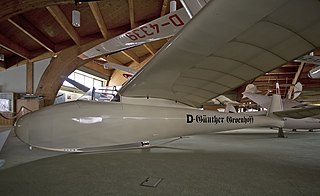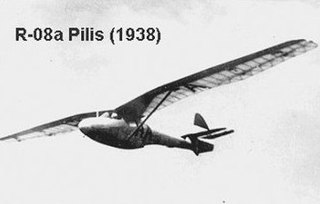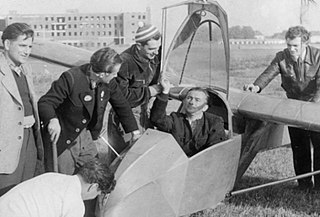Related Research Articles

The Antonov A-9 was a single-seat sailplane designed and built in the USSR in the 1940s, a development of the record setting Red Front 7.
The CVV1 Pinguino was a single seat, high performance glider designed and built in Italy in the mid-1930s, the first of a series of gliders from the Milan Polytechnic. It did not go into production.
The CVV 3 Arcore was a single seat competition glider designed and built in Italy in the late 1930s, a development of the CVV 1 Pinguino. It participated in several national gliding competitions in the short period before the outbreak of World War II.
The CVV 5 Papero was a single seat competition glider designed and built in Italy in the late 1930s, a development of the CVV 4 Pellicano.

The DFS Rhönsperber, otherwise known as the Schweyer Rhönsperber or Jacobs Rhönsperber was a single seat competition glider designed in Germany by Hans Jacobs and first flown in 1935. For several years it was regarded as the best German sailplane and about one hundred were built.

The DFS Reiher was a single seat competition glider designed in Germany by Hans Jacobs and first flown in 1937. The type won the last two German Rhön gliding championships before the start of World War II. Six were factory produced.

The Schleicher Rhönadler, DFS Rhönadler or Jacobs Rhönadler is a high performance, single seat competition sailplane built in Germany in the 1930s. More than 65 were built.
The Caproni Vizzola MF and 2 were single-seat gliders built in Italy just before World War II. Intended as training aircraft capable of aerobatics, the two variants differed only in their fuselages. Only one of each was built, but they were both successful in Italian competitions.
The Teichfuss Supergrifo or Super Grifo was an Italian competition glider designed by Luigi Teichfuss and flown in 1935. Only one was built.
The CAT 28BP was an Italian development of the licence built Dittmar Condor II into a high performance tandem two seat glider. Built in 1938, it anticipated the post-war, two seat Dittmar Condor IV and held the Italian national distance record for many years.
The DFS Sperber Junior was a competition sailplane designed for Hanna Reitsch and built in Germany in 1936.

The Oberlerchner Mg 19 Steinadler is an Erwin Musger designed two seat tandem trainer glider built in Austria and first flown in 1951. Several examples of this successful aircraft, which competed in the two seat class at two World Gliding Championships in the 1950s, were still flying in 2000.
The Svachulay Szent György was a small, single-seat glider built in Hungary in the early 1930s. Two slightly different examples were completed and flown successfully, but persistent concerns about structural strength eventually saw them grounded.

The Rubik R-03 Szittya I was a Hungarian single-seat sailplane flown in the late 1930s. The design was developed through three improving variants. though only one of each was built.
The Jancsó-Szokolay M22 was a Hungarian single-seat sailplane first flown in 1937. Twenty were built and the type set several national records. Some remained in service up to about 1953.

The Rubik R-08 Pilis was a Hungarian single-seat, advanced training glider first flown in 1939. It was very successful; 269 were built in batches, the first starting in 1939 and the last in 1956.
The Rubik R-17 Móka (Joy) was a Hungarian aerobatic glider designed in the late 1930s. One prototype was built and first flown in 1944 but was destroyed near the end of World War II. Two more, with modified ailerons and a new fuselage, were built in 1950 but were abandoned after a fatal accident.

The Spalinger S.21 is a Swiss two-seat trainer glider flown in the late 1930s. They were heavily used as trainers but also set many new Swiss national records in the two-seat category.

The Spalinger S.15 is a Swiss, single-seat training glider first flown in 1930. There were several variants, of which only the 1934 S.15K was serially produced. One restored example remains active in 2019.
The Groshev GN-7 was a high performance Soviet sailplane flown in the mid-1930s and built in quantity. In 1937 it set a new world distance record.
References
- 1 2 3 4 5 6 7 8 9 Brütting, Georg (1973). Die berühmtesten Segelflugzeuge. Stuttgart: Motorbuch Verlag. p. 123-4. ISBN 3-87943171-X.
- 1 2 3 4 5 6 7 8 9 10 11 Simons, Martin (2006). Sailplanes 1920-1945 (2nd revised ed.). Königswinter: EQIP Werbung & Verlag GmbH. pp. 218, 220. ISBN 3-9806773-4-6.
- 1 2 "Spalinger 18 III" . Retrieved 29 May 2019.
- 1 2 3 "Swiss Aircraft Register" . Retrieved 5 June 2019.
- ↑ Ogden, Bob (2009). Aviation Museums and Collections of Mainland Europe. Air Britain (Historians) Ltd. p. 210. ISBN 978-0-85130-418-2.
- ↑ "Spalinger 18 I" . Retrieved 29 May 2019.
- ↑ "Spalinger 18 II" . Retrieved 29 May 2019.